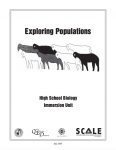Exploring Populations
View This Resource
This Immersion Unit provides a coherent series of lessons designed to guide students in developing deep conceptual understanding that is aligned with the standards, key science concepts, and essential features of classroom inquiry (as defined by the National Science Education Standards).
Unit Overarching Concepts
- Populations of living organisms change or stay the same over time as a result of the interactions between the genetic variations that are expressed by the individuals in the populations and the environment in which the population lives.
- Science knowledge advances through inquiry.
Unit Supporting Concepts
- Individual organisms with certain variations of traits (adaptations) are more likely than others to survive and reproduce successfully.When environmental conditions change it can affect the survival of both individual organisms and entire species.
- Natural selection determines the differential survival of groups of organisms.
- A small advantage in escaping a predator, resisting a drug, etc. can lead to the spread of a trait in a modest number of generations.
- Mutations are a source of variation in an individual’s genotype, and it can result in a change in phenotype––good or bad.
- Scientific progress is made by asking meaningful questions and conducting careful investigations, using appropriate tools and technology to perform tests, collect data, analyze relationships, and display data.
- No matter how well one scientific explanation fits observations, a new explanation might fit them just as well or better, or might fit a wider range of observations. In science, the testing, revising, and occasional discarding of explanations, new and old, never ends.
This unit was developed through the large Math and Science Partnership project called System-wide Change for All Learners and Educators (SCALE), involving a collaboration among Los Angeles School District educators, California State University science and education faculty, and UW-Madison SCALE staff.
Alternate Title
Variation as related to genetics and environment: Natural Selection and Evolution
Subject
Species
Phenotypic Trait
Genotype
Materials Development Era
Resource Type
- Instructional Material (DCMI Type Vocabulary)
- Instructional Material -- Lesson/Lesson Plan (DCMI Type Vocabulary)
- Instructional Material -- Unit of Instruction (DCMI Type Vocabulary)
- Instructional Material -- Experiment/Lab Activity (DCMI Type Vocabulary)
- Instructional Material -- Instructor Guide/Manual (DCMI Type Vocabulary)
Language
Typical Learning Time
8-10 weeks
Education Level
Creator
Contributor
Rights
This work by Wisconsin Fast Plants Program is licensed under Attribution-NonCommercial-ShareAlike 4.0 International
Date Issued
1997
Classification
- Educational Resources
- Educational Resources -- Grade Level: Secondary
- Educational Resources -- Grade Level: Undergraduate
- Educational Resources -- Grade Level: Middle School
- Educational Resources -- Grade Level: Middle School -- Classic Middle Level Resources (developed before the year 2010)
- Educational Resources -- Grade Level: Undergraduate -- Classic Undergraduate Level Resources (developed before the year 2010)
- Educational Resources -- Grade Level: Secondary -- Classic Secondary Resources (developed before the year 2010)
NGSS Standard
- NGSS.HS.LS3.2 Make and defend a claim based on evidence that inheritable genetic variations may result from: (1) new genetic combinations through meiosis, (2) viable errors occurring during replication, and/or (3) mutations caused by environmental factors. [Clarification Statement: Emphasis is on using data to support arguments for the way variation occurs.] [Assessment Boundary: Assessment does not include the phases of meiosis or the biochemical mechanism of specific steps in the process.]
- NGSS.HS.LS4.4 Construct an explanation based on evidence for how natural selection leads to adaptation of populations. [Clarification Statement: Emphasis is on using data to provide evidence for how specific biotic and abiotic differences in ecosystems (such as ranges of seasonal temperature, long-term climate change, acidity, light, geographic barriers, or evolution of other organisms) contribute to a change in gene frequency over time, leading to adaptation of populations.]
- NGSS.MS.LS3.2 Develop and use a model to describe why asexual reproduction results in offspring with identical genetic information and sexual reproduction results in offspring with genetic variation. [Clarification Statement: Emphasis is on using models such as Punnett squares, diagrams, and simulations to describe the cause and effect relationship of gene transmission from parent(s) to offspring and resulting genetic variation.]
- NGSS.MS.LS4.4 Construct an explanation based on evidence that describes how genetic variations of traits in a population increase some individuals’ probability of surviving and reproducing in a specific environment. [Clarification Statement: Emphasis is on using simple probability statements and proportional reasoning to construct explanations.]
- NGSS.MS.LS4.6 Use mathematical representations to support explanations of how natural selection may lead to increases and decreases of specific traits in populations over time. [Clarification Statement: Emphasis is on using mathematical models, probability statements, and proportional reasoning to support explanations of trends in changes to populations over time.] [Assessment Boundary: Assessment does not include Hardy Weinberg calculations.]

Comments